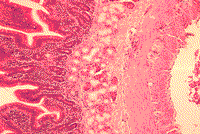 Identify the tissue:
Identify the tissue:
Question 1 - Single Best Answer
A) colon
B) stomach
C) esophagus
D) duodenum
E) small intestine
Question 2 - Single Best Answer
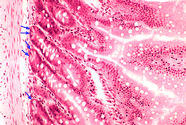 Identify the cell at the tip of the arrow:
Identify the cell at the tip of the arrow:
A) parietal cell
B) oxyphil cell
C) chief cell
D) goblet cell
E) paneth cell
F) APUD cell
Question 3 - Single Best Answer
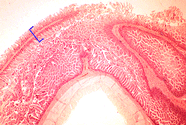 Identify the structure as indicated by the bracket:
Identify the structure as indicated by the bracket:
A) gland
B) villus
C) plicae circulares
D) crypt
E) Peyer's patch
Question 4 - Single Best Answer
A) esophagus
B) small intestine
C) colon
D) duodenum
E) stomach
Question 5 - Single Best Answer
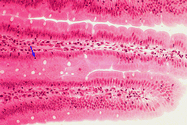 Identify the cell at the tip of the arrow:
Identify the cell at the tip of the arrow:
A) mucous cell
B) melanocyte
C) lymphocyte
D) goblet cell
E) keratinocyte
Question 6 - Single Best Answer
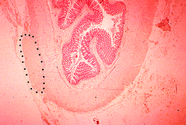 Identify the structure indicated by the dots:
Identify the structure indicated by the dots:
A) skeletal muscle
B) internal anal sphincter
C) muscularis mucosa
D) external anal sphincter
E) taenia coli
Question 7 - Single Best Answer
 Identify the cell at the tip of the arrow:
Identify the cell at the tip of the arrow:
A) goblet cell
B) chromaffin cell
C) paneth cell
D) chief cell
E) parietal cell
F) APUD cell
Question 8 - Single Best Answer
A) duodenum
B) stomach
C) small intestine
D) colon
E) esophagus
Question 9 - Single Best Answer
A) colon
B) lip
C) tongue
D) rectum
E) scalp
Question 10 - Single Best Answer
 Identify the cell at the tip of the arrow:
Identify the cell at the tip of the arrow:
A) parietal cell
B) chief cell
C) chromaffin cell
D) paneth cell
E) oxyphil cell
Question 11 - Single Best Answer
A one week old newborn infant is not able to go home because he has not had a bowel movement since birth. He also has features consistent with Down's syndrome. This is a chromosome abnormality (trisomy at chromosome 21) that includes a phenotype in which the child has slanted eyes, a space between the first and second toe, and a crease that spans the entire width of the palm of the hand. A biopsy specimen from his colon is shown. What is wrong with this picture?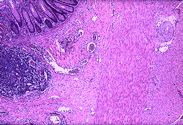
A) There are no villi
B) There are too many cells in the submucosa
C) It is a normal specimen
D) There are no ganglia (Auerbach's and Meissner's plexi).
Question 12 - Single Best Answer
Which limb of the nervous system is involved?
A) peripheral nervous system
B) central nervous system
C) ganglionic nervous system
D) autonomic nervous system
Question 13 - Single Best Answer
Which points to the normal internal anal sphincter (which would also lack ANS cells in this patient)?
A)
B)
C)
D)
Question 14 - Single Best Answer
A 50 year old female presents to the office with abdominal pain, weight loss, and diarrhea. After extensive testing, the patient is diagnosed with inflammatory bowel disease (Crohn's disease). This disease can affect any part of the GI tract(mouth to anus). In the acute stage of the disease, which cell would you expect to see?
A) PMN
B) monocyte
C) basophill
D) mast cell